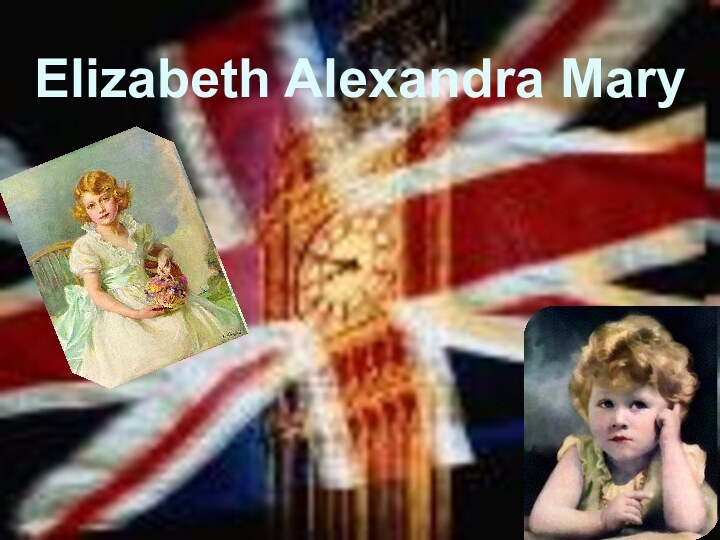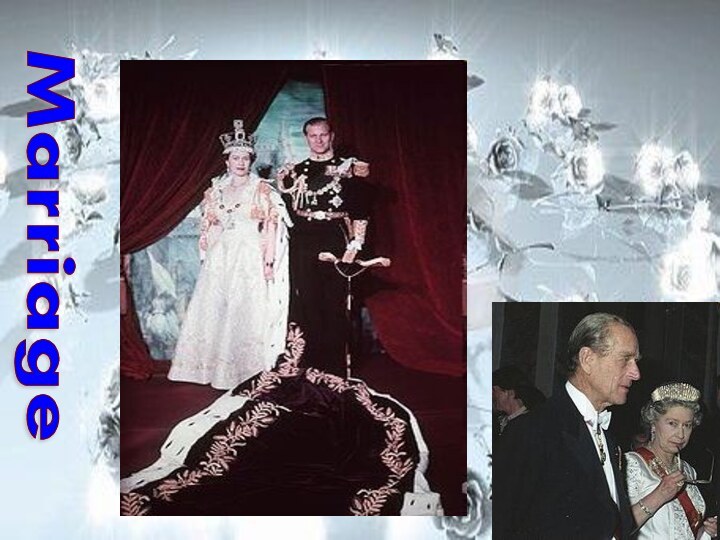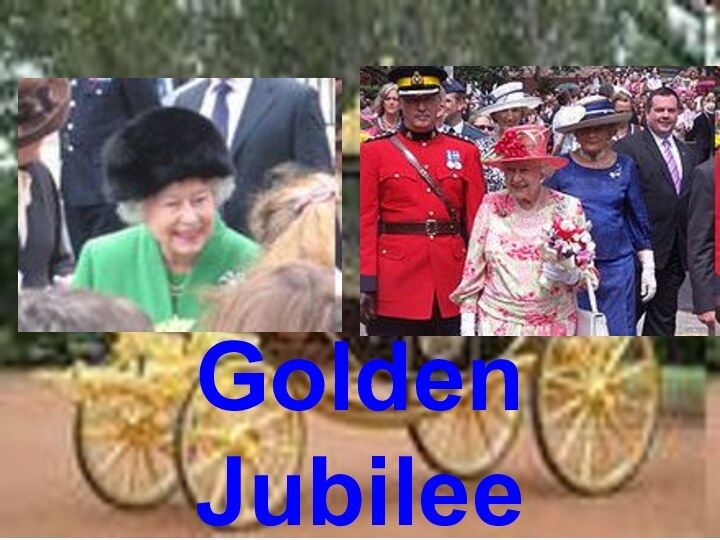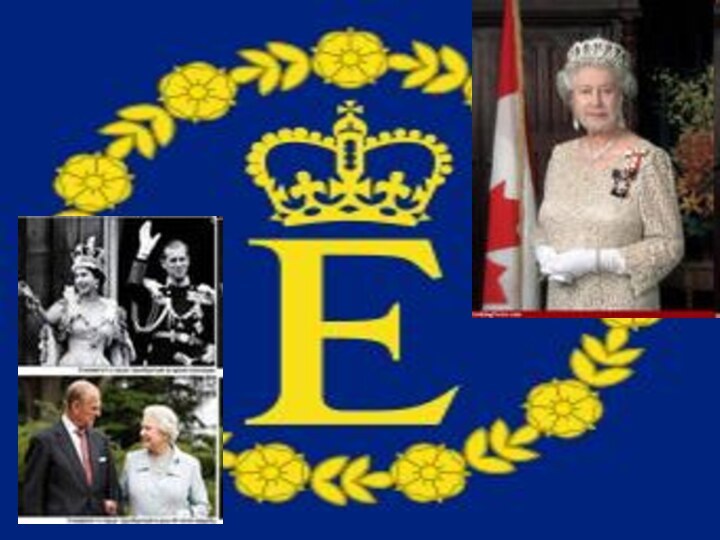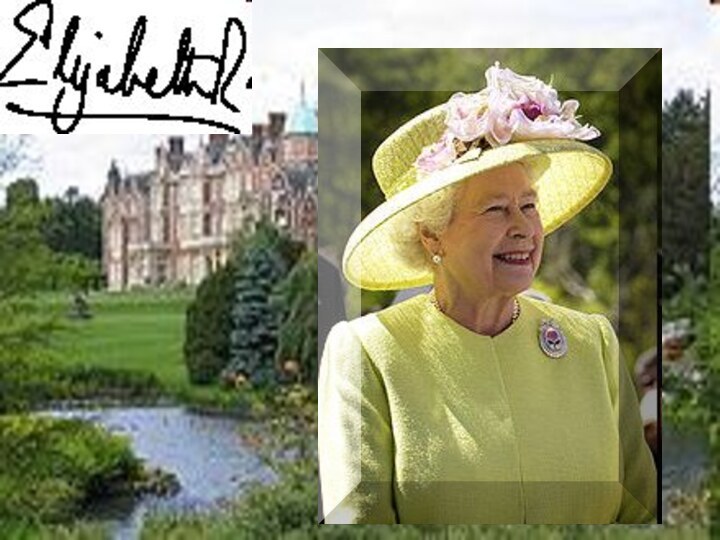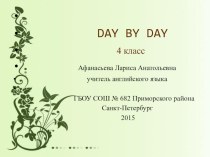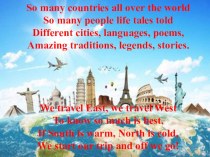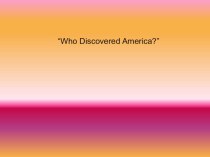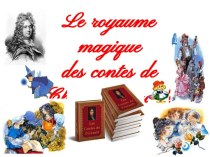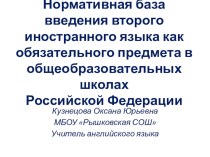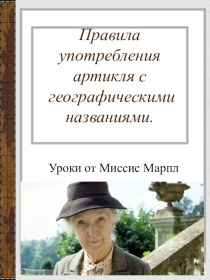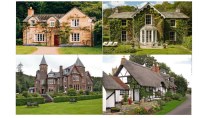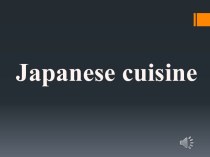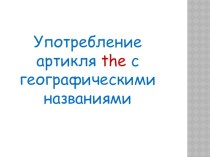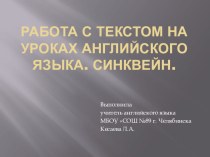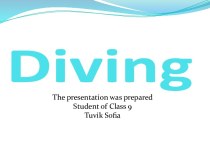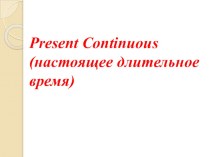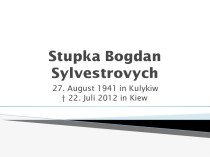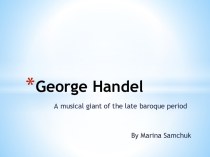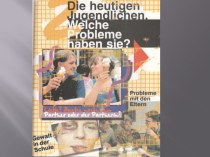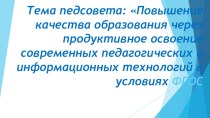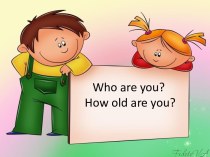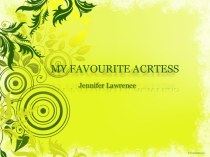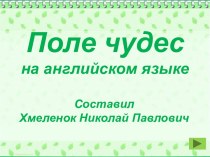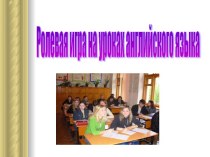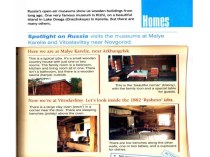Слайд 3
the Women's Auxiliary Territorial Service
Слайд 10
Early life.
Elizabeth was the first child of Prince
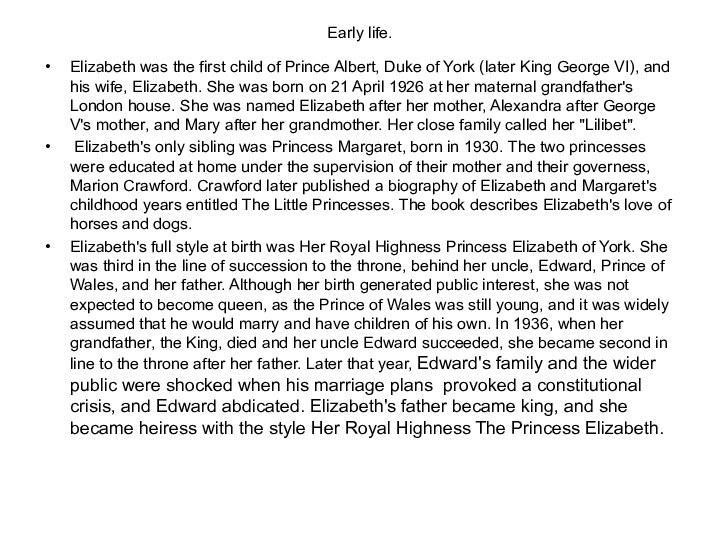
Albert, Duke of York (later King George VI), and
his wife, Elizabeth. She was born on 21 April 1926 at her maternal grandfather's London house. She was named Elizabeth after her mother, Alexandra after George V's mother, and Mary after her grandmother. Her close family called her "Lilibet".
Elizabeth's only sibling was Princess Margaret, born in 1930. The two princesses were educated at home under the supervision of their mother and their governess, Marion Crawford. Crawford later published a biography of Elizabeth and Margaret's childhood years entitled The Little Princesses. The book describes Elizabeth's love of horses and dogs.
Elizabeth's full style at birth was Her Royal Highness Princess Elizabeth of York. She was third in the line of succession to the throne, behind her uncle, Edward, Prince of Wales, and her father. Although her birth generated public interest, she was not expected to become queen, as the Prince of Wales was still young, and it was widely assumed that he would marry and have children of his own. In 1936, when her grandfather, the King, died and her uncle Edward succeeded, she became second in line to the throne after her father. Later that year, Edward's family and the wider public were shocked when his marriage plans provoked a constitutional crisis, and Edward abdicated. Elizabeth's father became king, and she became heiress with the style Her Royal Highness The Princess Elizabeth.
Слайд 11
The second World War.
In 1943, 16-year-old Elizabeth undertook
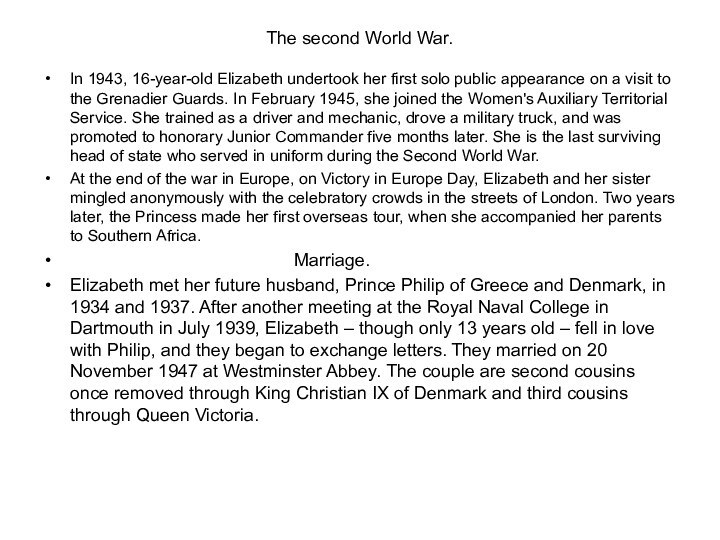
her first solo public appearance on a visit to
the Grenadier Guards. In February 1945, she joined the Women's Auxiliary Territorial Service. She trained as a driver and mechanic, drove a military truck, and was promoted to honorary Junior Commander five months later. She is the last surviving head of state who served in uniform during the Second World War.
At the end of the war in Europe, on Victory in Europe Day, Elizabeth and her sister mingled anonymously with the celebratory crowds in the streets of London. Two years later, the Princess made her first overseas tour, when she accompanied her parents to Southern Africa.
Marriage.
Elizabeth met her future husband, Prince Philip of Greece and Denmark, in 1934 and 1937. After another meeting at the Royal Naval College in Dartmouth in July 1939, Elizabeth – though only 13 years old – fell in love with Philip, and they began to exchange letters. They married on 20 November 1947 at Westminster Abbey. The couple are second cousins once removed through King Christian IX of Denmark and third cousins through Queen Victoria.
Слайд 12
Before the marriage, Philip renounced his Greek and

Danish titles and adopted the style Lieutenant Philip Mountbatten,
taking the surname of his mother's British family. Just before the wedding, he was created Duke of Edinburgh and granted the style of His Royal Highness.
The marriage was not without controversy: Philip had no financial standing, was foreign-born and had sisters who had married German noblemen.
Elizabeth and Philip received 2500 wedding gifts from around the world. In post-war Britain, it was not acceptable for any of the Duke of Edinburgh's German relations to be invited to the wedding, including Philip's three surviving sisters
Elizabeth gave birth to her first child, Prince Charles, on 14 November 1948, a second child, Princess Anne, was born in 1950.
Following their wedding, the couple leased Windlesham Moor near Windsor Castle, until 4 July 1949, when they took up residence at Clarence House in London. At various times between 1949 and 1951, the Duke of Edinburgh was stationed in Malta (at that time a British Protectorate) as a serving Royal Navy officer. The children remained in Britain.
Слайд 13
Reign.
Coronation - June 1953.
George VI's health declined during
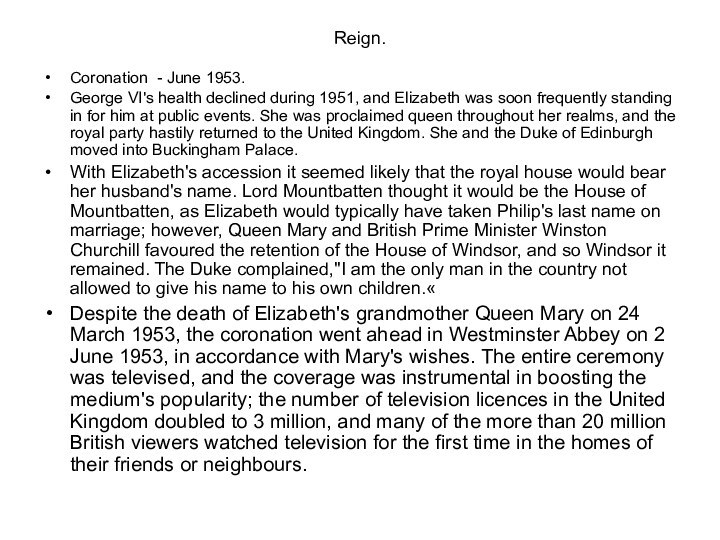
1951, and Elizabeth was soon frequently standing in for
him at public events. She was proclaimed queen throughout her realms, and the royal party hastily returned to the United Kingdom. She and the Duke of Edinburgh moved into Buckingham Palace.
With Elizabeth's accession it seemed likely that the royal house would bear her husband's name. Lord Mountbatten thought it would be the House of Mountbatten, as Elizabeth would typically have taken Philip's last name on marriage; however, Queen Mary and British Prime Minister Winston Churchill favoured the retention of the House of Windsor, and so Windsor it remained. The Duke complained,"I am the only man in the country not allowed to give his name to his own children.«
Despite the death of Elizabeth's grandmother Queen Mary on 24 March 1953, the coronation went ahead in Westminster Abbey on 2 June 1953, in accordance with Mary's wishes. The entire ceremony was televised, and the coverage was instrumental in boosting the medium's popularity; the number of television licences in the United Kingdom doubled to 3 million, and many of the more than 20 million British viewers watched television for the first time in the homes of their friends or neighbours.
Слайд 14
Elizabeth wore a gown, which was embroidered with
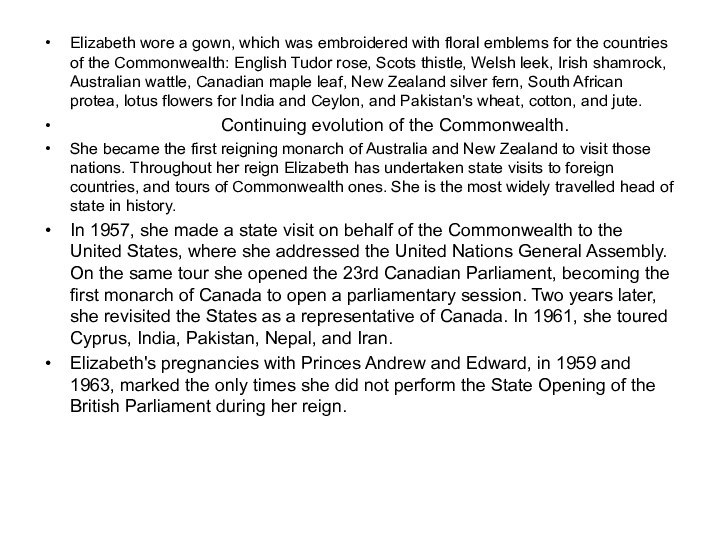
floral emblems for the countries of the Commonwealth: English
Tudor rose, Scots thistle, Welsh leek, Irish shamrock, Australian wattle, Canadian maple leaf, New Zealand silver fern, South African protea, lotus flowers for India and Ceylon, and Pakistan's wheat, cotton, and jute.
Continuing evolution of the Commonwealth.
She became the first reigning monarch of Australia and New Zealand to visit those nations. Throughout her reign Elizabeth has undertaken state visits to foreign countries, and tours of Commonwealth ones. She is the most widely travelled head of state in history.
In 1957, she made a state visit on behalf of the Commonwealth to the United States, where she addressed the United Nations General Assembly. On the same tour she opened the 23rd Canadian Parliament, becoming the first monarch of Canada to open a parliamentary session. Two years later, she revisited the States as a representative of Canada. In 1961, she toured Cyprus, India, Pakistan, Nepal, and Iran.
Elizabeth's pregnancies with Princes Andrew and Edward, in 1959 and 1963, marked the only times she did not perform the State Opening of the British Parliament during her reign.
Слайд 15
In 1977, Elizabeth marked the Silver Jubilee of
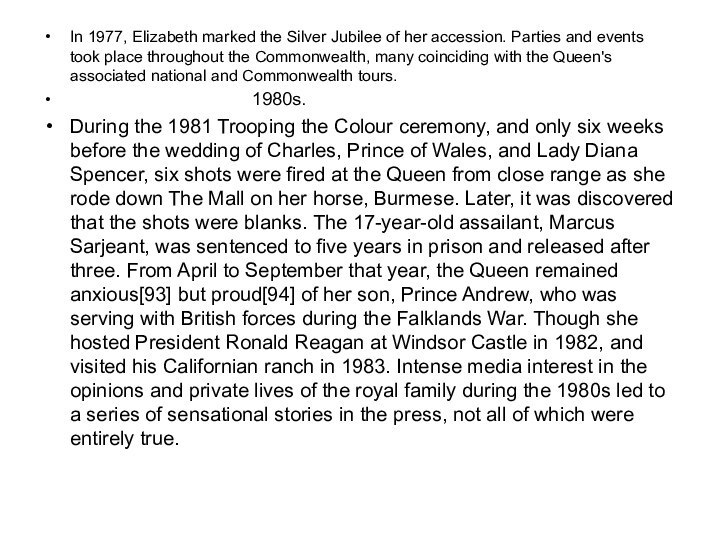
her accession. Parties and events took place throughout the
Commonwealth, many coinciding with the Queen's associated national and Commonwealth tours.
1980s.
During the 1981 Trooping the Colour ceremony, and only six weeks before the wedding of Charles, Prince of Wales, and Lady Diana Spencer, six shots were fired at the Queen from close range as she rode down The Mall on her horse, Burmese. Later, it was discovered that the shots were blanks. The 17-year-old assailant, Marcus Sarjeant, was sentenced to five years in prison and released after three. From April to September that year, the Queen remained anxious[93] but proud[94] of her son, Prince Andrew, who was serving with British forces during the Falklands War. Though she hosted President Ronald Reagan at Windsor Castle in 1982, and visited his Californian ranch in 1983. Intense media interest in the opinions and private lives of the royal family during the 1980s led to a series of sensational stories in the press, not all of which were entirely true.
Слайд 16
In a speech on 24 November 1992, to

mark the 40th anniversary of her accession, the Queen
called 1992 her "annus horribilis", meaning horrible year. In March, her second son Prince Andrew, Duke of York, and his wife Sarah, Duchess of York, separated. In April, her daughter Anne, Princess Royal, divorced her husband Captain Mark Phillips. During a state visit to Germany in October, angry demonstrators in Dresden threw eggs at her, and in November Windsor Castle suffered severe fire damage. In December, Charles and Diana formally separated
Golden Jubilee
In 2002, Elizabeth marked her Golden Jubilee as queen. As in 1977, there were street parties and commemorative events, and monuments were named to honour the occasion. A million people attended each day of the three-day main Jubilee celebration in London, and the enthusiasm shown by the public for Elizabeth was greater than many journalists had predicted.
Though Elizabeth has enjoyed good health throughout her life, in 2003 she had keyhole surgery on both knees, and in June 2005 she cancelled several engagements after contracting a bad cold.
The Queen and the Duke of Edinburgh celebrated their 60th wedding anniversary in 2007; their marriage is the longest of any British monarch. The Queen's reign is longer than those of her four immediate predecessors combined (Edward VII, George V, Edward VIII, and George VI). She is the third-longest-reigning monarch of the United Kingdom, the second-longest-serving current monarch of a sovereign state and the oldest reigning British monarch. She has no intention of abdicating.

